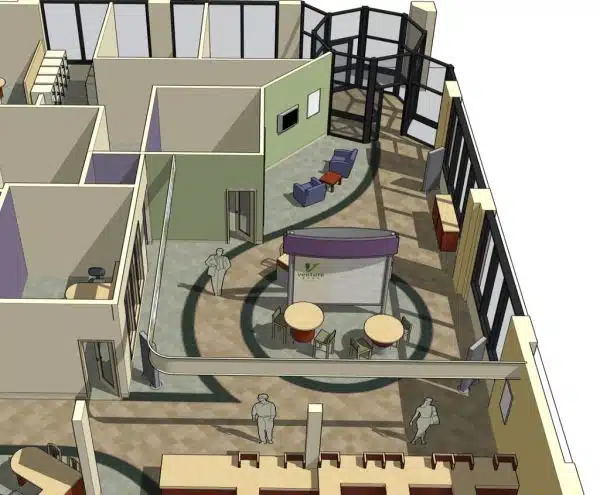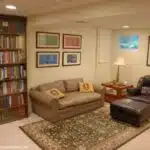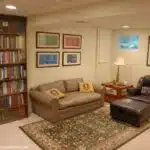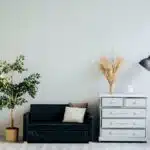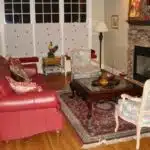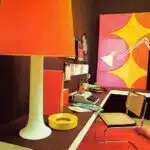As an interior design expert, one of the most frequent questions I get asked is how to create a decorating plan for a home. Many homeowners struggle with this task, as they may not know where to start or how to bring their vision to life. However, creating a decorating plan is essential in ensuring that your home is not only aesthetically pleasing but also functional and comfortable.
In this article, we will explore the steps you can take to create a decorating plan for your home. From determining your personal style to establishing a budget and timeline, we will provide practical tips and advice that will help you achieve your desired outcome. By following these guidelines, you can turn your house into the dream home that reflects your personality while providing comfort and functionality for yourself and others.
Assessing Your Living Space
Before embarking on a home decorating project, it’s important to assess your living space thoroughly. This involves measuring the space so that you have accurate dimensions to work with. Measuring the area will help you determine what furniture and decor will fit comfortably in each room without overcrowding or making it feel too sparse. Once you have the measurements, create a floor plan using graph paper or online tools such as RoomSketcher or Home Designer Suite.
Finding inspiration is an essential part of any home decorating plan. Inspiration can come from several sources, including design magazines, websites, social media platforms like Pinterest and Houzz, and visiting showrooms and open houses. It’s crucial to take note of the design elements that appeal most to you for future reference. When exploring these different sources of inspiration, try not to get overwhelmed by the limitless options available. Instead, focus on finding styles that align with your personal taste and lifestyle needs.
It’s important to keep in mind that assessing your living space and finding inspiration are just two small components of creating a successful decorating plan for your home. The next step is defining your personal style, which will help guide all of your design decisions moving forward. By understanding what styles resonate with you most deeply, it becomes easier to choose furniture pieces and accessories that will bring out the best in your living spaces.
Defining Your Personal Style
Identifying Your Preferences is an important first step in creating a decorating plan for your home. Creating a Vision Board is a great way to explore different styles and evaluate your likes and dislikes. Analyzing your habits and needs and understanding your budget are essential components when researching trends and inspirations for your color palette. Selecting furniture, choosing lighting, incorporating textures, accessorizing with artwork, deciding on window treatments, shopping for fabrics, and adding finishing touches are all important elements that complete your personal style.
Identifying Your Preferences
When it comes to creating a decorating plan for your home, one of the crucial steps is identifying your preferences. As an interior design expert, I recommend exploring textures and finding inspiration to help you define your personal style. The texture of materials used in a room can significantly impact the overall visual appeal. Therefore, you should take time to explore different textures such as silk, leather, cotton, wool or linen to determine which ones appeal to you most.
Finding inspiration can be challenging; however, it’s essential if you want to create a decorating plan that reflects your personality and preferences. Start by looking at different interior design magazines or visiting showrooms to see how others have decorated their homes. Take note of color schemes and patterns that appeal to you most and consider how you could incorporate them into your space.
Additionally, consider exploring other sources of inspiration such as nature or art. Nature provides endless inspiration with its vast array of colors and textures while art offers an opportunity to incorporate unique pieces into your space that reflect your personality. By taking time to identify your preferences through exploration and inspiration, you’ll be able to define your personal style and create a decorating plan that truly reflects who you are.
Creating A Vision Board
One effective way to define your personal style and create a decorating plan that reflects it is by using Pinterest to create a vision board. A vision board, also known as a mood board, is a visual representation of the design elements you want to incorporate into your space. It’s an excellent tool for bringing all of your ideas together in one place.
Using Pinterest makes creating a vision board easy and convenient. You can browse through thousands of images related to interior design and pin the ones that resonate with you. Organize your pins into different boards based on color schemes, themes, or specific rooms in your home. This will help you see how all of the elements come together and make adjustments as needed.
The benefits of creating a vision board are numerous. It allows you to see how different colors, patterns, and textures work together before making any purchases or decisions. Additionally, it helps you stay focused on your overall design goals and ensures that everything in your space works cohesively. By taking advantage of this powerful tool, you’ll be able to define your personal style with confidence and create a beautiful home that truly reflects who you are.
Setting A Budget
Creating a Budget
Before you start decorating your home, it is important to set a budget. Without a budget, it is easy for expenses to spiral out of control. One way to save money on decor is by exploring DIY options. There are numerous online tutorials and videos that provide step-by-step instructions for creating your own decor items. Not only will this save you money, but it also allows you to add a personal touch to your space.
Another option is hiring an interior designer. While this may seem like an added expense, an interior designer can actually help you save money in the long run by preventing costly mistakes and ensuring that everything fits and flows together seamlessly. However, it is important to weigh the pros and cons before making a decision. Hiring an interior designer can be expensive and may not always be necessary depending on the scope of your project.
By setting a budget at the beginning of your decorating process, you will have a better understanding of what you can afford and what areas you may need to cut back on. It also helps ensure that you don’t overspend on unnecessary items or decor pieces that don’t align with your overall vision for the space. In the next section, we will discuss how to establish a timeline for your decorating plan without sacrificing quality or efficiency.
Establishing A Timeline
Symbolism can be a powerful tool in interior design. Just as colors and textures can evoke specific moods, so too can the passage of time. When creating a decorating plan for your home, it’s important to establish a timeline that will keep you on track and help you achieve your goals. By breaking down your project into manageable chunks, you’ll be able to stay focused and motivated throughout the process.
Creating a schedule is the first step in establishing a timeline for your decorating project. Start by setting a deadline for when you want the project to be completed, then work backwards from there. Identify key milestones along the way, such as when you need to have certain materials ordered or when specific tasks should be completed. Be sure to build in some flexibility for unexpected delays or changes in plans.
Staying on track is essential if you want to complete your project on time and within budget. Delegating tasks to family members or seeking help from professionals can help ensure that everything gets done according to schedule. By working together with others, you’ll be able to share the workload and keep each other accountable. Remember that communication is key – make sure everyone involved knows what their responsibilities are and when they need to be completed.
As you establish your timeline, keep in mind that prioritizing your needs and wants will play an important role in determining which tasks should take priority over others. In the next section, we’ll explore how to identify these priorities and use them to create a cohesive decorating plan that meets both your functional and aesthetic needs.
Prioritizing Your Needs And Wants
After establishing a timeline, the next step in creating a decorating plan for your home is to prioritize your needs and wants. Balancing these two elements can be challenging, especially when you have a limited budget. However, by making compromises and being strategic about where you invest your money, you can create a space that reflects your personal style while also meeting your practical needs.
To help prioritize your needs and wants, it can be helpful to create a table like the one below:
| Needs | Wants | |
|---|---|---|
| Living Room | Comfortable seating | Statement artwork |
| Kitchen | Ample storage space | High-end appliances |
| Bedroom | Quality mattress | Luxurious bedding |
This table allows you to visually organize your priorities by room. Once you have identified your essential needs for each space, you can then start thinking about which of your wants are most important to you.
When making compromises for your budget, it’s important to consider the long-term value of each investment. For example, investing in high-quality furniture that will last for years is often a better use of funds than splurging on trendy decor items that may quickly go out of style. By balancing practicality with aesthetics and being intentional about where you spend your money, you can create a beautiful and functional space that meets both your needs and wants.
A logical next step after prioritizing your needs and wants is choosing a color scheme that ties everything together seamlessly. By selecting colors that complement each other and reflect the mood or atmosphere you want to create in each room, you can further enhance the overall look and feel of your home.
Choosing A Color Scheme
Did you know that 62% of people choose their favorite color for the walls of their home? Color is a powerful tool that can evoke emotions and set the tone for a room. When choosing a color scheme for your home, it’s important to consider color psychology and how different colors can affect mood. For example, blues and greens are calming colors, while yellows and reds are energizing.
Once you’ve considered color psychology, it’s time to decide on a specific color scheme. One popular option is monochromatic, which uses different shades of the same color. This creates a cohesive look without being too overwhelming. Another option is complementary, which pairs opposite colors on the color wheel. This creates contrast and visual interest in a room.
When implementing your chosen color scheme, don’t be afraid to incorporate accent walls. These are walls painted in a bold or contrasting color to add visual interest to a room without overwhelming it with too much color. Accent walls can also be used to highlight architectural features such as fireplaces or built-in shelves.
As you move forward with your decorating plan, keep in mind the power of color and how it can affect mood in your home. Next up, we’ll discuss selecting furniture and accessories that complement your chosen color scheme.
Selecting Furniture And Accessories
- When selecting furniture and accessories for a room, it is important to decide on a style that is cohesive and fits the existing decor.
- Carefully selecting the right pieces ensures the desired aesthetic of the room is achieved.
- Shopping around for furniture pieces should incorporate both form and function to create a well-balanced space.
- Accents are a great way to add personality and bring the room to life.
- From wall art to pillows and rugs, incorporating accents is an important part of creating a unique and inviting space.
- A key consideration when selecting furniture and accessories is to ensure that everything works together and creates a unified look.
Deciding On A Style
Choosing a style for your home is the foundation of any decorating plan. It sets the tone for all further design decisions and allows you to create a cohesive look throughout your space. One important factor to consider when choosing a style is color. Choosing the right colors can make or break a design scheme, so it’s important to take time to select the perfect palette that complements your personal taste.
Another way to find inspiration for your decorating plan is through travel. Traveling allows you to experience different cultures and styles, which can spark new ideas and give you fresh perspectives on design. Whether it’s exploring art museums in Paris or wandering through the markets in Morocco, there are endless opportunities to discover new textures, patterns, and color combinations that can be incorporated into your home decor.
In summary, selecting a style for your home is an essential step in creating a decorating plan. Consider factors such as color and travel experiences when making your decision. By taking these steps, you can create a space that reflects your personal taste while also incorporating unique elements inspired by the world around you.
Finding The Right Pieces
When it comes to selecting furniture and accessories, finding the right pieces is crucial in achieving a cohesive and visually appealing design scheme. It’s not just about picking out items that you like; instead, it’s about considering how each piece will contribute to the overall look and feel of your space. One way to find unique and affordable pieces is by thrifting. Thrifting tips include visiting local thrift stores, garage sales, and estate sales. Online shopping is also an option for those who prefer convenience.
Thrifting can be a fun and rewarding experience for those who have the patience to search for hidden gems. When thrifting for furniture and accessories, keep an open mind and don’t be afraid to get creative with repurposing or upcycling items. For instance, an old ladder can be turned into a stylish bookshelf or a vintage suitcase can serve as a statement piece in your living room. Online shopping is another convenient way to find unique pieces from all over the world. However, it’s essential to read reviews carefully before making any purchases.
In conclusion, finding the right furniture and accessories is an important aspect of creating a cohesive design scheme in your home. Thrifting tips such as visiting local thrift stores and estate sales can help you find unique pieces at affordable prices. Additionally, online shopping provides another option for those who prefer convenience. By taking the time to search for the perfect pieces, you can create a space that reflects your personal style while also incorporating interesting elements from different eras and cultures.
Incorporating Accents
When it comes to selecting furniture and accessories, incorporating accents is a crucial aspect of creating a visually appealing design scheme. Accents can be used to add pops of color and texture to a space, making it feel more inviting and personalized. One way to incorporate colorful accents is by adding throw pillows or blankets in bright hues. These items can be easily switched out seasonally or when you want to refresh the look of your space.
Another way to incorporate accents is through DIY projects. DIY accents add a unique touch to your space while also allowing you to express your creativity. For instance, painting an accent wall or creating a gallery wall with personal photos can add character and charm to any room. Additionally, repurposing old items such as mason jars or wine bottles into vases or candleholders is a fun and sustainable way to incorporate accents into your decor.
Incorporating accents into your design scheme can transform your space from ordinary to extraordinary. By using colorful accents and DIY projects, you can create a personalized and inviting atmosphere that reflects your style and personality. Remember, the key is not just about finding pieces that you like, but rather considering how each element will contribute to the overall look and feel of your home.
Incorporating Lighting
Layering lighting is an essential aspect of any decorating plan. It involves the use of multiple light sources to create a well-lit and inviting space. The three layers of lighting include ambient, task, and accent lighting. Ambient lighting is the primary source that illuminates the entire room, while task lighting focuses on specific areas like the kitchen or study area. Accent lighting highlights artwork or architectural features.
Choosing light fixtures can be overwhelming with so many options available. However, selecting the right fixture for each layer of lighting is crucial to achieving your desired ambiance. For ambient lighting, consider using overhead fixtures like chandeliers or pendant lights. Task lighting requires focused fixtures such as desk lamps or under-cabinet lights in the kitchen. Accent lighting can be achieved through wall sconces or track lights.
Remember that layering your lighting should not only provide functionality but also create a warm and welcoming atmosphere in your home. So, when choosing your light fixtures and bulbs, consider their color temperature as it affects the mood in a room. Warm-toned bulbs create a cozy ambiance while cool-toned bulbs are perfect for task-oriented spaces like offices or studies.
Incorporating proper layered lighting into your decorating plan will elevate your home’s overall design aesthetic and functionality. In our next section, we will discuss creating focal points by incorporating statement pieces into your decor without overwhelming your space with unnecessary clutter.
Creating Focal Points
Just as a star shines brightest when it is the center of attention, your home should have its own focal point that draws the eye and captures the imagination. Creating a focal point is an essential aspect of interior design, as it adds depth and character to any space. A statement piece is often used to create this effect, but there are many other ways to create a visual anchor in your home.
When selecting a statement piece for your home, consider pieces that are unique and reflect your personal style. This could be an art piece, sculpture, or even a vintage item with sentimental value. Once you have selected your statement piece, arrange the rest of the room’s decor around it to highlight its beauty and significance. This will help create cohesion in the space while also showcasing your prized possession.
Wall decor ideas are another excellent way to create focal points within your home. Gallery walls featuring frames of varying sizes and styles can add visual interest and depth to any room. Alternatively, large-scale artwork or murals can provide a dramatic backdrop for furniture arrangements and make an impactful statement within any space. Whatever you choose, remember that creating a focal point is about capturing attention and creating meaning in every corner of your home.
As important as creating visual interest through focal points may be, arranging furniture and decor around these elements is equally crucial. In our next section, we will explore how to arrange furniture in ways that enhance both function and aesthetics within each room of your home. By following these tips on creating focal points in combination with strategic furniture placement, you’ll be able to craft spaces that are both beautiful and functional for yourself or any guests who come into them!
Arranging Furniture And Decor
Furniture placement and decor placement are two essential components of a decorating plan. Correctly positioning your furniture and decor can make a significant difference in the overall look and feel of your home. It’s crucial to consider the scale and proportion of each item to ensure they fit proportionally in the room.
When arranging furniture, it’s essential to create a functional layout that complements your lifestyle. Begin by identifying the focal point of the room, such as a fireplace or a large window, and arrange your furniture around it. Consider the traffic flow and ensure there is enough space for people to move around comfortably. Additionally, placing furniture in groups can create an intimate setting while still providing ample seating.
Decor placement involves adding finishing touches such as artwork, decorative objects, and lighting fixtures that complement the overall theme of the room. When placing decor items, consider how they will interact with other elements in the room. For example, if you have bold wallpaper or patterned upholstery on your couch, choose simple decorative pieces that won’t compete for attention with these larger design elements.
Transition: Now that you’ve arranged your furniture and placed decor items strategically, it’s time to add texture and pattern to elevate the design of your home.
Adding Texture And Pattern
Arranging furniture and decor is the first step in creating a well-decorated home, but it’s not the only consideration. To truly elevate your space, you must also focus on mixing textures and combining patterns. This will add depth and visual interest to your home, making it feel more dynamic and inviting.
When it comes to mixing textures, aim for a variety of materials like wood, metal, glass, and fabrics. A sleek metal lamp can be paired with a rustic wooden side table for an interesting contrast. Textured throw pillows or blankets can add warmth to a leather sofa or accent chair. Don’t be afraid to mix different finishes as well – shiny surfaces can play off matte ones for a beautiful effect.
Similarly, combining patterns is an art form that requires careful consideration. Start with one large patterned piece – like a rug or wallpaper – then use smaller prints in complementary colors to build around it. Mixing stripes with florals or geometric shapes with organic motifs can create a visually stunning result when done properly. Remember that balance is key; if you have too many patterns vying for attention, the overall effect may become overwhelming.
Maximizing storage is the next step in creating a functional and beautiful living space. By carefully considering your storage needs and choosing furniture pieces that can serve multiple purposes – like an ottoman that doubles as storage space – you can keep clutter at bay while maintaining your home’s style. In the next section, we’ll explore how to make the most of every inch of your available storage space without sacrificing aesthetics.
Maximizing Storage
One of the biggest challenges in interior design is maximizing storage without sacrificing aesthetics. Utilizing shelves can be a great solution to this problem, as they not only provide additional storage space but also add visual interest to a room. When choosing shelves, consider their material and design as well as their function. For example, floating shelves can create a modern, minimalist look while built-in bookshelves can add a more traditional feel.
There are also many creative storage ideas that can help you make the most out of your space. For example, using furniture with built-in storage such as ottomans or beds with drawers underneath can be a great way to save space while still having functional pieces. Another idea is to use decorative baskets or boxes to store items such as magazines or blankets. This not only adds visual interest but also keeps clutter at bay.
Incorporating ample storage options into your decorating plan not only helps keep your home organized but also ensures that it remains aesthetically pleasing. By utilizing shelves and other creative storage ideas, you can make the most out of your available space while adding unique touches to your home decor. In the next section, we will discuss how considering sustainability can further enhance your decorating plan.
Considering Sustainability
- Furniture recycling can be an effective and relatively inexpensive way to furnish a home in a sustainable fashion.
- Reusing materials is a great way to create a unique and eco-friendly atmosphere in one’s home.
- Utilizing reclaimed wood, vintage furniture, and second-hand items can reduce the amount of new materials used.
- Selecting eco-friendly paints for a home decorating project is an important step in creating a sustainable environment.
- Low-VOC and zero-VOC paints are available in a variety of colors and finishes, providing a sustainable decorating option.
- Incorporating sustainable practices into home decorating plans is an important aspect of creating a green interior.
Recycling Furniture
When it comes to decorating your home, sustainability is a key factor that should not be overlooked. It is important to consider how your choices impact the environment. One way to achieve this is by recycling furniture, which can help reduce waste and lower your carbon footprint. Upcycling techniques and repurposing materials are great ways to breathe new life into old pieces of furniture.
Upcycling techniques involve transforming old items into something new and useful. For example, an old dresser could be painted and turned into a unique bathroom vanity. Repurposing materials involves taking an item and using it for a different purpose than it was originally intended for. For instance, an old wooden ladder could be turned into a bookshelf or coat rack. Both of these methods can save you money while also reducing waste.
Recycling furniture not only benefits the environment, but it also adds character and personality to your home decor. By incorporating upcycling techniques and repurposing materials, you can create one-of-a-kind pieces that showcase your creativity and style. So before tossing out that old piece of furniture, consider giving it a second life through recycling!
Reusing Materials
As an interior design expert, one of the most important factors to consider when decorating your home is sustainability. It is crucial to think about how your choices affect the environment and future generations. One way to achieve this is by reusing materials, which can help reduce waste and promote sustainable DIY projects.
Upcycling materials is a great way to reuse old items and transform them into something new and useful. For example, an old wooden pallet could be turned into a unique coffee table or a headboard for your bed. This not only helps lower your carbon footprint but also adds character and personality to your home decor.
Sustainable DIY projects that involve reusing materials not only benefit the environment, but they can also save you money. By finding creative ways to repurpose items you already have, you can create one-of-a-kind pieces that showcase your creativity and style. So why not give it a try? Take a look around your home and see what items can be upcycled or repurposed into something beautiful!
Eco-Friendly Paints
When it comes to considering sustainability in interior design, another crucial factor to consider is the type of paint used. Traditional paints can contain harmful chemicals that can be damaging to both the environment and our health. Eco-friendly paints are a great alternative as they are made from natural, non-toxic ingredients that have minimal impact on the environment.
The benefits of using eco-friendly paint are numerous. They do not release toxic fumes or emit harmful chemicals into the air, making them safer for both humans and pets. Additionally, these paints often have low VOC (volatile organic compound) levels, which means they have less impact on indoor air quality. Furthermore, eco-friendly paint brands are often more transparent about their ingredients and manufacturing processes, which helps consumers make informed decisions.
However, there are also some drawbacks to using eco-friendly paint. They can be more expensive than traditional paints, which may deter some homeowners from choosing them. Furthermore, eco-friendly paints may not always offer the same color range or finish options as traditional paints. It’s important to do your research and find a brand that offers the colors and finishes you desire while still being environmentally conscious.
Some of the best eco-friendly paint brands include Farrow & Ball, BioShield Paints, and Sherwin-Williams Harmony Interior Acrylic Latex Paint. These brands use natural ingredients such as clay and plant oils instead of synthetic materials like petroleum-based resins or formaldehyde. By using these types of paints in your home decor projects, you can reduce your carbon footprint while still achieving beautiful results that promote sustainability in interior design.
Seeking Inspiration
As the saying goes, “a picture is worth a thousand words.” When it comes to seeking inspiration for your home decorating plan, visual aids can be an excellent source. Start by gathering images from magazines, Pinterest boards, and other design blogs that reflect your personal style. Take note of recurring themes and color schemes, as well as how different pieces work together to create a cohesive look.
Another place to look for inspiration is in nature. The colors and textures found in the outdoors can provide a calming and grounding influence on your design choices. Take a walk outside and observe the way light plays with shadows or how the colors of leaves change throughout the seasons. You may find unexpected combinations that spark new ideas for your decorating plan.
Once you have gathered inspiration from various sources, it’s time to curate your ideas into actionable steps. Start by creating a vision board or collage that incorporates your favorite elements from each source. This will help you identify which pieces you need to purchase or repurpose and give you a clear idea of how they will work together in your space. Remember to prioritize function over form – beautiful decor is only useful if it serves its purpose in your daily life.
Incorporating inspiration into your decorating plan is just the beginning of bringing your space to life. In the next section, we’ll explore how to turn those actionable steps into tangible changes that will transform any room into a haven of comfort and beauty.
Bringing Your Plan To Life
Once you have your decorating plan in place, it’s time to bring it to life. Depending on the complexity of your plan, there are a few different ways you can go about doing this. One option is to tackle some DIY projects yourself. This can be a fun and rewarding way to personalize your space while also saving money. However, keep in mind that some projects may require specialized skills or tools that you don’t have.
If you’re feeling overwhelmed by the prospect of DIY projects, consider hiring professionals to help bring your plan to life. Interior designers, contractors, and other experts can offer valuable guidance and expertise, helping you make informed decisions about materials, layouts, and more. While hiring professionals may be more expensive than tackling projects yourself, it can be worth the investment if you want to ensure that your home looks its best.
Ultimately, the key to bringing your decorating plan to life is staying organized and patient. Take things one step at a time and don’t rush the process – remember that creating a beautiful home takes time and effort. With a little persistence and creativity, you’ll be able to turn your vision into reality and enjoy a space that feels truly personalized and inviting.
Conclusion
When it comes to creating a decorating plan for your home, there are several important steps to consider. First and foremost, assessing your living space is crucial in order to determine what changes need to be made. Defining your personal style is also essential, as this will guide all of your design choices going forward.
Setting a budget and establishing a timeline are equally important factors that should not be overlooked. Prioritizing your needs and wants will help you make the most of your resources while maximizing storage and considering sustainability will ensure that your space is functional and eco-friendly.
It’s also important to seek inspiration from various sources such as magazines, online blogs, or even social media platforms like Instagram or Pinterest. Finally, bringing your plan to life requires careful execution of each step in the process.
According to recent studies, home renovation spending in the United States has increased by over 50% since 2010. This statistic highlights the growing interest in home design and decoration among homeowners across the country. As an interior design expert, I encourage everyone to take the time to create a thoughtful decorating plan that reflects their personal style while also considering practical factors like budget and storage needs. By following these simple steps, anyone can achieve their dream home decor without breaking the bank or sacrificing functionality.
Image Credits
- “Bank Space Planning | 3D Bank Design | Bank Decor Design | Interior Bank Décor | Venture Bank” by I-5 Design & Manufacture (featured)

